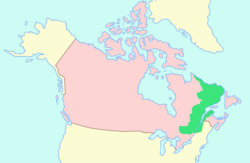Republic of Lower Canada
| Republic of Lower Canada | ||||||||||
| République du Bas-Canada | ||||||||||
|
||||||||||
|
|
||||||||||
| Capital | Montreal | |||||||||
| Languages | French, English | |||||||||
| Government | Republic | |||||||||
| President | ||||||||||
| • | 1838 | Robert Nelson | ||||||||
| Legislature | Representative Democracy | |||||||||
| Historical era | Lower Canada Rebellions | |||||||||
| • | Declaration of Independence | 22 February 1838 | ||||||||
| • | Battle of Odelltown | 9 November 1838 | ||||||||
|
||||||||||
| Today part of | ||||||||||
The Republic of Lower Canada was a break-away Republic proclaimed in the aftermath of the 1837 Rebellions. The defeat of the rebellion meant that the state could never be properly established.
A British colony since 1760, Canada was divided in two distinct entities in 1791: Lower Canada, mainly inhabited by the descendants of the colonists of New France, and Upper Canada, mainly inhabited by British colonists and American Loyalists who established themselves as refugees of the American Revolution. Each entity had its own elected assembly.
The francophones, who were the majority in Lower Canada, wished to take into their own hands important decisions regarding the administration of the colony. However, a massive frustration emerged because the assembly was soon restricted to an aesthetical role; the real legislative and executive power was concentrated in the hands of the Governor-General, chosen by London, who often misunderstood or belittled the interests of the people of Lower Canada, which were at times contradictory to those of the British colonial authorities.
The unstable political situation, lack of individual ministerial responsibility of the colonial government; as well as the economic crisis and the recent independence of the United States and of Latin American states led the people of Lower Canada, in the autumn of 1837, to the Lower Canada Rebellions. The poorly armed, untrained and outnumbered Patriotes were quickly defeated by the British Army. The survivors sought refuge in the United States.
...
Wikipedia


